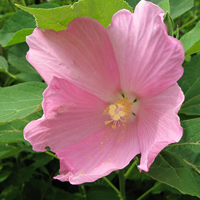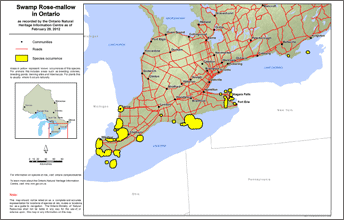Swamp rose-mallow
Scientific name: Hibiscus moscheutos

Cover photo credit: Rob Tervo
Status
Special Concern
“Special Concern” means the species lives in the wild in Ontario, is not endangered or threatened, but may become threatened or endangered due to a combination of biological characteristics and identified threats.
Date added to the Species at Risk in Ontario List
The Swamp rose-mallow was already assessed as a species of special concern when the Endangered Species Act took effect in 2008.
What it looks like
The Swamp rose-mallow is a perennial member of the mallow family. Reaching about two metres in height, this large wetland plant produces showy, pink or white-petalled flowers in summer. The petals measure six to 10 centimetres long. Each flower opens for one or two days, and fades as soon as it is pollinated. Leaves are alternate and variable in shape from lance-like to three-lobed.
Where it lives
In Ontario, Swamp rose-mallow is restricted to shoreline marshes, in the Carolinian and Great Lakes - St. Lawrence forest regions, associated with lakes Erie, Ontario or St. Clair.
Swamp rose-mallow is most commonly found in deep-water cattail marshes and in meadow marshes. It reaches its greatest numbers in dyked wetlands, where competition from other plants is controlled and the open habitat is maintained by periodic flooding. It is also found in open wet woods, thickets, spoil banks, and drainage ditches.
Where it’s been found in Ontario
The Swamp rose-mallow range in North America extends from the lower Great Lakes region south to Florida and west to New Mexico. It may be adventive (introduced and locally common) farther west. In Ontario, it has been found at approximately 60 to 70 sites and is believed to currently occur at about 50 sites. Most sites are in coastal marshes of Lake Erie and Lake St. Clair. However, in the last 15 years, plants have colonized sites on the shores of Lake Ontario, expanding the distribution northwards. The species has also been introduced to Europe where it is locally common.
View a larger version of this map (PDF)
What threatens it
Wetland drainage, shoreline development, and the spread of invasive species, are the main threats for the Swamp rose-mallow in Ontario. Through natural succession, its habitat can be gradually overtaken by shrubs unless kept open by periodic flooding or fire. Two invasive plants, European common reed (Phragmites australis subsp. australis) and hybrid cattail (Typha x glauca), have recently spread into some of the sites, where they crowd out Swamp rose-mallow and other native plants.
Action we are taking
Special concern species do not receive species or habitat protection.
What you can do
Report a sighting
The Ministry of Natural Resources and Forestry tracks species at risk. Report a sighting of an endangered animal or plant to the Natural Heritage Information Centre. Photographs with specific locations or mapping coordinates are always helpful.
Volunteer
Volunteer with your local nature club or provincial park to participate in surveys or stewardship work focused on species at risk.
Be a good steward
- private land owners have a very important role to play in species recovery; you may be eligible for stewardship programs that support the protection and recovery of species at risk and their habitats
- invasive species seriously threaten many of Ontario’s species at risk; to learn what you can do to help reduce the threat of invasive species, visit:
Report illegal activity
Report any illegal activity related to plants and wildlife to 1-877-TIPS-MNR .
Quick facts
- the total Canadian population of Swamp rose-mallow is estimated to consist of fewer than 10,000 plants
- water level fluctuations that periodically expose and then re-flood — thus controlling phragmites, shrubs, and small trees — are probably critical for the long-term survival of this species in Canada
